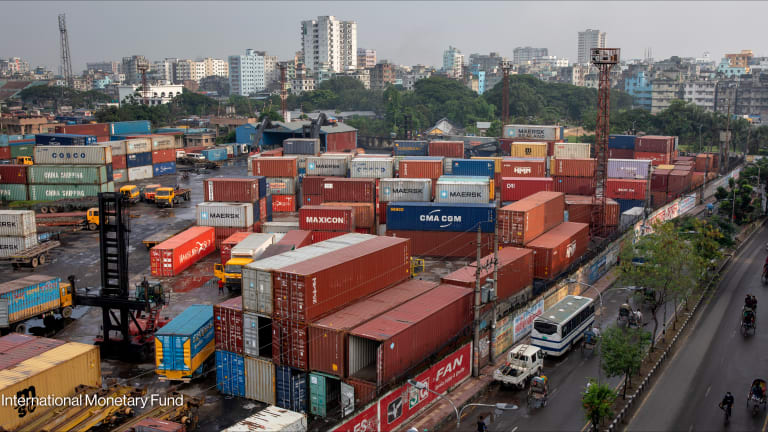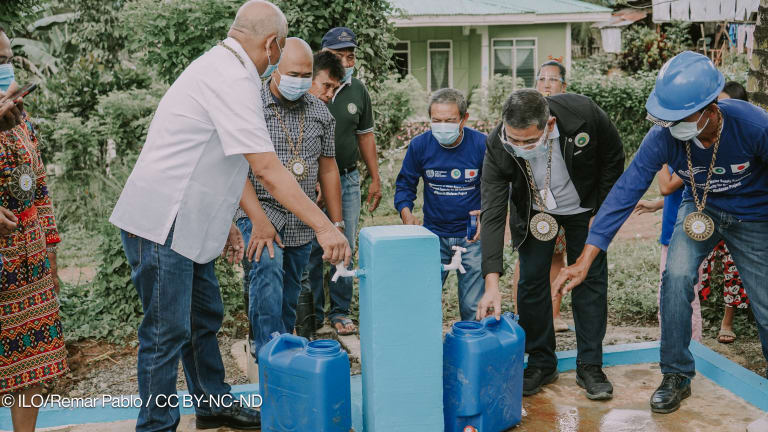Emerging donors giving on one hand, receiving on the other
Even as emerging donors tout their foreign aid largesse as proof of their rising economic standing, several of these up-and-coming development players actually still receive substantial amounts of foreign aid.
Despite signs of slowing growth, global development’s emerging donors have seen steady and sustained increases in their foreign aid budgets in recent years. That’s just one of the key findings from last week’s Devex research report, which examined the budgets, priorities and practices of eight emerging donors: the BRICS economies, Turkey, the United Arab Emirates and South Korea. Yet even as these up-and-coming development players tout their foreign aid largesse as proof positive of their newfound economic standing, five of the donors we profiled actually continue to receive substantial amounts of foreign aid: Brazil, India, South Africa, Turkey and Russia. Below, Devex takes a closer look at foreign aid flows to these five emerging donors. If incoming ODA figures from the Organization for Economic Cooperation and Development are compared with government figures for outgoing aid, then only South Africa and India seem to receive more aid than they give out. It’s worth noting that while each of the five emerging donors that receive foreign aid still face pressing development challenges at home, not a single one is considered dependent on external assistance. In 2013, South Africa’s ODA receipts accounted for only 0.4 percent of its national income, already the highest level among the five countries. Among the eight emerging donors profiled for the Devex research report, only China and South Korea can credibly claim to have firmly made the leap from aid recipient to donor, while the United Arab Emirates has never been a major recipient of foreign aid. Brazil Brazil gave out $731 million in foreign aid in 2010, the latest year when those figures are available, even as it received $453 million in ODA that same year. Brazil’s ODA receipts have since nearly tripled to $1.2 billion in 2013. Forestry (49 percent), water supply and sanitation (10 percent) and energy (9 percent) claimed over two-thirds of Brazil’s ODA receipts in 2013. Norway accounted for nearly half of ODA to Brazil in 2013, ahead of Germany, which accounted for 19 percent. Back in 2008, Norway promised Brazil as much as $1 billion through 2015 to combat deforestation, a focus area for Norwegian aid. Brazil is the single-biggest recipient of Norwegian aid. Germany’s robust development presence in Brazil meanwhile seems to be tied to German aid’s heavy focus on middle-income countries. Representing just 2 percent of ODA to Brazil in 2013, the United States, on the other hand, has recently transitioned the U.S. Agency for International Development’s mission in Brasilia to a strategic partnership mission designed to promote trilateral cooperation with Brazil’s emerging donor program. India India received $2.4 billion in ODA in 2013, even as it gave out $1.1 billion in foreign aid the same year. Over a decade ago, the Indian government had announced that it would only accept bilateral aid from five countries and the European Union, but New Delhi seems to have backtracked on that decision. Transport (20 percent) and health (18 percent) claimed the bulk of India’s ODA receipts in 2013. Japan and the World Bank are the two biggest sources of ODA for India. Heavily focused on financing India’s infrastructure needs, the two donors together accounted for just over half of ODA to the country in 2013. Under the World Bank’s latest country partnership strategy for India, the bank does plan to hike its support for social sectors, like education and health, in low-income Indian states. Another major donor to India, the United Kingdom is slated to discontinue its bilateral aid to India by the end of 2015 — part of the Cameron administration’s efforts to redirect British aid to poorer countries. In 2013, the United Kingdom accounted for a tenth of ODA to India, behind only Japan, the World Bank and Germany. South Africa In 2013, South Africa received $1.3 billion in ODA, dwarfing Pretoria’s $183 million foreign aid budget that year. Since 2009, South Africa’s ODA receipts have held steady at between $1 billion and $1.4 billion a year. Well ahead of any other sector, health garnered 45 percent of South Africa’s ODA receipts in 2013. Representing the highest share of ODA (33 percent) to South Africa in 2013, the United States directs the vast majority of its assistance to the country’s HIV and AIDS response through the U.S. President’s Emergency Plan for AIDS Relief. The Obama administration seems to have slowed the withdrawal of PEPFAR funding for South Africa, a move that had been designed to transition PEPFAR to host country ownership. As in the case of India, the United Kingdom also plans to end its bilateral aid program in South Africa by this year. In 2013, the United Kingdom accounted for 7 percent of ODA to South Africa, behind the European Union, which accounted for 12 percent. In contrast, the European Union has exempted South Africa from its aid differentiation policy, which slashes EU aid to middle-income countries. Turkey In 2013, Turkey received $2.8 billion in ODA, while at the same time giving out $3.3 billion in development assistance. Turkey’s ODA receipts have dropped from a high of $3.3 billion in 2011, when humanitarian aid poured in following a devastating earthquake in the eastern part of the country. Banking and financial services (31 percent) and transport (18 percent) garnered nearly half of Turkey’s ODA receipts in 2013. By far the single-biggest donor to Turkey, the European Union accounted for nearly 80 percent of ODA to the country in 2013. The top recipient of EU aid, Turkey receives financial assistance from Brussels through the Instrument for Pre-accession Assistance, the EU aid financing instrument supporting political and economic reforms in EU candidate countries. The EU has excluded the IPA from its aid differentiation policy, which slashes EU aid to middle-income countries. Citing Turkey’s standing as an “equal economic partner,” the German government announced in 2012 that it had ended its bilateral cooperation with Turkey in favor of innovative financing and triangular cooperation arrangements. A year later, however, Germany remained a major donor to Turkey, accounting for 9 percent of ODA to the country, a share exceeded only by the EU. Russia While the OECD stopped collecting ODA data for Russia in 2004, a previous Devex analysis revealed that three major aid donors — the World Bank, the European Union and Sweden — have sustained their development engagement with Russia over the past decade. The biggest of Russia’s aid donors, the World Bank committed $111 million in financing for the country in 2014. Of this amount, $60 million was directed toward the Hydrometeorological Services Modernization Project. Russian ODA, which reached $714 million in 2013, seems to far exceed the country’s aid receipts. At the same time, however, Moscow’s alleged aggressive actions in Ukraine over the past year have prompted both the European Investment Bank and the European Bank for Reconstruction and Development to freeze new financing for projects in Russia. Claiming that USAID had interfered in its internal affairs, Russia controversially expelled the U.S. aid agency back in 2012. Check out more funding trends analyses online, and subscribe to Money Matters to receive the latest contract award and shortlist announcements, and procurement and fundraising news.
Despite signs of slowing growth, global development’s emerging donors have seen steady and sustained increases in their foreign aid budgets in recent years. That’s just one of the key findings from last week’s Devex research report, which examined the budgets, priorities and practices of eight emerging donors: the BRICS economies, Turkey, the United Arab Emirates and South Korea.
Yet even as these up-and-coming development players tout their foreign aid largesse as proof positive of their newfound economic standing, five of the donors we profiled actually continue to receive substantial amounts of foreign aid: Brazil, India, South Africa, Turkey and Russia.
Below, Devex takes a closer look at foreign aid flows to these five emerging donors. If incoming ODA figures from the Organization for Economic Cooperation and Development are compared with government figures for outgoing aid, then only South Africa and India seem to receive more aid than they give out.
This story is forDevex Promembers
Unlock this story now with a 15-day free trial of Devex Pro.
With a Devex Pro subscription you'll get access to deeper analysis and exclusive insights from our reporters and analysts.
Start my free trialRequest a group subscription Printing articles to share with others is a breach of our terms and conditions and copyright policy. Please use the sharing options on the left side of the article. Devex Pro members may share up to 10 articles per month using the Pro share tool ( ).
Lorenzo is a former contributing analyst for Devex. Previously Devex's senior analyst for development finance in Manila.








